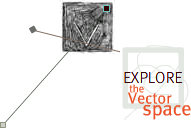
Almost twenty years ago I had a telling conversation with a retired military officer who had served as an air force pilot during the Vietnam War. When asked about his experiences in and of that country, he replied, "Vietnam didn't exist for me as a place; it was more of a target." Pushed to expand on his statement, he explained that he mostly interacted with Vietnam from above as he traversed the region by plane. He went on to describe his visual memories of the country as framed by the shape of and technologies in the cockpits he inhabited -- as vast, panoramic fields of green and brown punctuated and made meaningful by the overlays of his viewfinder and the contours of his windshield. People, houses, even whole villages were abstracted into a machinic vision that served to sever action from effect. Pilots, he asserted, just "saw things differently" and had an "easier time" during the war, a veiled reference to the devastation left behind in the wake of planes like his, a consequence his aerial perspective made easier to disavow.
For nearly two decades this conversation has resonated for me as a powerful object lesson about the technological mediation of perception. Throughout this same period, an array of scholars from a number of fields has tracked the many ways that the machines we interact with co-produce what we can perceive and know. Works as diverse as Wolfgang Schivelbusch's exploration of the railway journey to Jonathan Crary's treatise on optical devices to Carolyn Marvin's investigation of the telephone and electricity remind us that both "new" and "old" technologies at once reflect and help constitute our individual and social understandings of place and time and of self and other. Our fourth issue of Vectors joins this lively conversation and examines the sensory, phenomenological, and epistemological stakes of
perception at different moments of history and in varied geographies, paying special attention to the cultural, ethical and ideological stakes of what, how, and when we perceive.
The rubric of "perception" offers a convenient throughline by which to weave together a number of fields, including geography, cognitive science, film studies, art history, philosophy, and the digital arts. Projects like those by Anne Friedberg, Caren Kaplan, and Laura Marks foreground the modes by which technology and information culture - from the camera obscura to the chronophotography of the U.S. military to the foliated Kufic script carved into the walls of the Al-Azhar Mosque - mediate our perception, delimiting and producing meaning from the sensory fields we inhabit in very precise ways. While some projects address techniques and devices that span hundreds of years, thus historicizing our understanding of the relationship of technology to perception, we are also concerned with the difference a specific medium or machine might make. Together, these seven works suggest that the digital era demands interpretive frameworks more attuned to the flow of digitized information, flexible models for charting both existing and emergent modes of experience and knowing.
Some pieces in this issue -- including those by Eric Faden, Perry Hoberman, and Donald Hoffman -- blur past and present, real and make believe, theory and art, playfully tweaking the borders of the user's perception. Other projects turn technology back upon itself to help us see what is usually hidden from sight, what things are not allowed - in Laura Marks' term - to 'unfold' into our sensory perception and into our knowledge. Trevor Paglen's "Unmarked Planes and Hidden Geographies" deploys flight tracking technologies to map worlds that are not supposed to exist, while Sharon Daniel's "Public Secrets" powerfully tests our ability to hear those voices society would rather ignore, creating a space for empathy, dialogue, and action.
In keeping with Vectors' mandate to mine the relationship of form to content, this issue allows us to ask a number of questions about the role of digital media in academic knowledge production, including "Can multimedia and interactive scholarship help us to understand perception better or differently?" and "Can digital media model multiple perspectives in ways that push beyond the sensory modes supported by print?". But these experiments in structure and meaning are not meant as hollow aesthetic exercises; rather, they are meant to help us "see things differently" in a manner that makes it difficult to disavow the politicized roles that technology plays in the construction of everyday life.


 Perception Issue Projects
Perception Issue Projects
